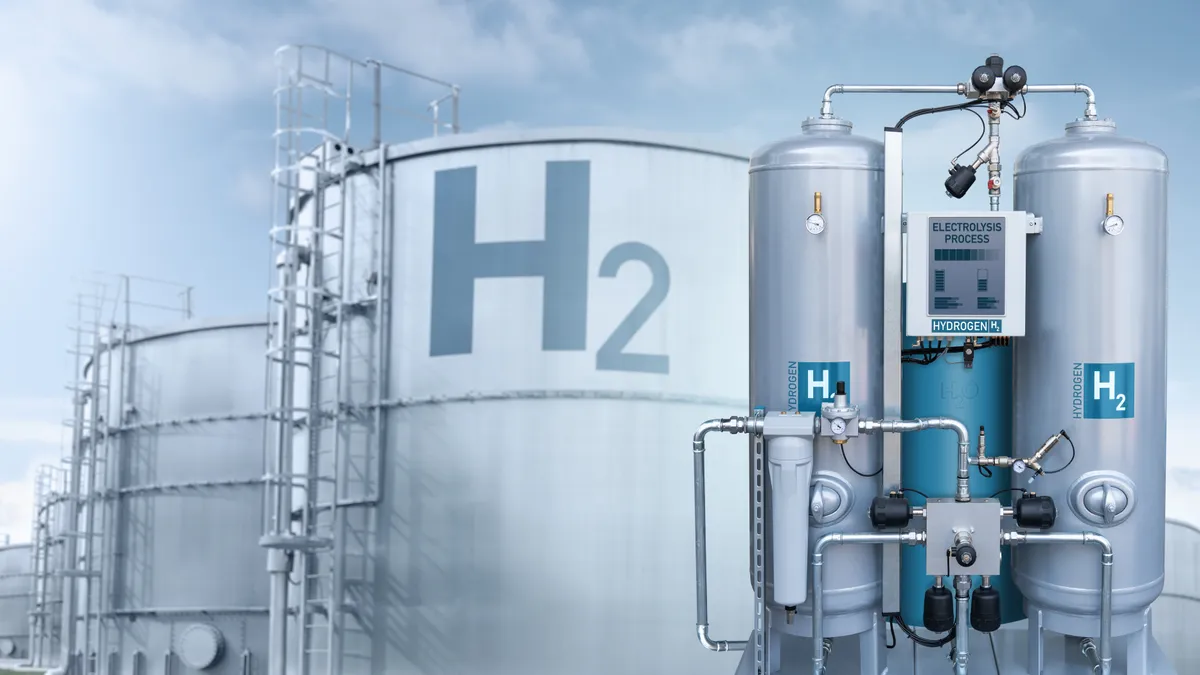Dive Brief:
-
Burning clean hydrogen for fuel could abate most carbon emissions from gas-fired power plants, but the cost of doing so would far outstrip the cost of other low-carbon baseload generation options, including the use of carbon capture and sequestration with existing fossil-powered plants and nuclear generation, according to a July 4 report by the Clean Air Task Force.
-
Burning electrolytic hydrogen made with clean energy would reduce lifecycle emissions by 90% relative to unabated natural gas, but at a levelized cost of $350-$470 per MWhe, according to the report. Nuclear power, by comparison, runs $130/MWhe, according to the Clean Air Task Force.
-
The cost of hydrogen-fired power also outstrips the cost of battery storage, which the Clean Air Task Force report estimated at $150-170/MWhe. However, the current duration of battery storage is largely limited to four hours and clean hydrogen could play a role in long-duration storage, an area where there are still few commercially feasible options, according to the report.
Dive Insight:
Clean hydrogen has a potential cost problem, according to the Clean Air Task Force, an environmental advocacy group.
The levelized cost of energy produced using clean electrolytic hydrogen could could exceed $400/MWhe, according to the report. If power plants burned hydrogen derived from natural gas, which is presumed to be a cheaper feedstock, the cost of the energy would still fall between $300-400/MWhe, according to the Clean Air Task Force.
The majority of that cost stems from the need to build out dedicated infrastructure for the storage and transportation of hydrogen, said Ghassan Wakim, hydrogen technology director for the Clean Air Task Force and one of the authors of the report. The Clean Air Task Force assumes a minimum price of $3/kg of hydrogen. Although the Department of Energy and other organizations have launched initiatives intended to drive down the cost of hydrogen production to $1/kg, Wakim said the Clean Air Task Force does not believe prices below $3/kg for delivered hydrogen will be feasible in the near future on account of the steep cost of storing and transporting hydrogen.
“When you take a look, as we were writing this paper, you start to realize the magnitude of the infrastructure you'd require,” Wakim said. “It's not really about the turbine itself or the compressor or the mechanics of the power plant that are the limiting factor, but it's more so how do you deliver the hydrogen.”
The report, which is based on publicly available data and proprietary in-house financial models, did not take tax credits or government incentives into account out of a desire to estimate the unsubsidized cost of hydrogen.
While the cost could rule out hydrogen as a strategy for decarbonizing electric generation, Wakim said he still sees a potential limited role for hydrogen in the power sector as a form of long-duration energy storage. Battery storage outperforms hydrogen based on cost, according to the report, as does pumped hydropower storage, which the Clean Air Task Force put at $100-130/MWhe. But today's batteries are limited in their duration, and pumped storage requires access to large reservoirs of water — something that isn't readily available in all areas. Hydrogen made from surplus renewable energy could fill gaps where no commercially plausible solution currently exists, Wakim said.
But there's also the question of the availability of excess clean energy. With booming energy demand from AI and electric vehicles, the amount of low-cost renewable energy available for hydrogen production could be quite limited in the near future, Kasparas Spokas, director of insights and integration strategy at the Clean Air Task Force, said. And the cost of hydrogen is heavily dependent on how often the electrolyzers that create it run.
“If you put up a small electrolyzer facility, you can design it so you have a high capacity factor, which ensures a low cost of hydrogen production,” Wakim said. “However the downside to this is you would only capture a fraction of the surplus electricity, which is not ideal. If you increase the size of the electrolyzers to capture all of the surplus electricity ... your utilization of that facility will be much smaller and the cost much higher.”
Given the potential limited availability of clean hydrogen made from excess renewable energy, Wakim said he believes the U.S. should prioritize the use of hydrogen in hard-to-abate industrial sectors such as steel making over uses within the electric system.














